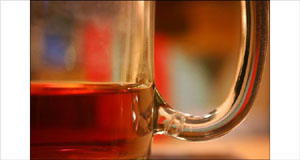Good tea makes stronger health
Big leaf tea does not mean that it is not good
In Russia, customers often come across falsified tea: even paying quite enough we can get product of poorer or worse quality. It is important to know several essential instructions to choose good and aromatic tea.
Now, Russia imports about 160 thousand tons of tea and produces about 13 thousand tons of tea every year. It is quite natural that Russia's population cannot consume the whole of the amount, so packs of tea may be sold overdue at stores. The RF State Commercial Inspection informs that 44 per cent of imported tea is fake, even though it is traditionally believed that Russia imports only best quality and quality #1 tea. If we look closely at the mixture in a pack of tea we may easily determine the quality of this tea.
As practice has demonstrated, tea packed in tins, porcelain or other expensive packages is seldom falsified. Flavored expensive tea sorts sold by weight are rather authentic. It is easier to fake carton packs and tea bags. Read inscriptions on tea packs: good tea sorts have the name and the address of the producer, the brand name and the use-by date printed on their packs. Unpack the tea and look closely at the leaves: even tealeaves prove high quality of tea, while dust and uneven tealeaves reveal poorer quality of the product.
Big leaf tea does not mean that it is not good. On the contrary, while brewing big tea leaves get unfolded and give wonderful taste and aroma to the tea. Small tea leaves make tea stronger, but not that delicate and tasty.
The price for elite tea brands also depends upon the area and the conditions of tea growing. Tea leaves may have different taste even if they are grown at nearby plantations but have slightly different humidity and light conditions.
Majority of Russian consumers prefer C.T.C. tea makes which are cheaper from the technological point of view. These are strong and rough tea makes: as the production processes are automated, this sort of tea loses a great part of useful components and aroma. Granulated tea is traditionally marked as C.T.C. tea.
Nowadays, green tea is gaining popularity in Russia. Some time ago, this tea was not in demand and could not be found in stores. But many centuries ago, people drank only green tea, the one that underwent no fermentation or oxidation procedures.
Both, black and green tea is made of the same green tea leaves, but different production technologies are employed. Black tea is made in five technological stages including withering, curling, drying and mixing, while green tea production includes just three stages (no fermentation is included). Fermentation gives particular color and aroma to tea and makes it what we know as black tea. However, this procedure also destroys some of useful components of tea. For example, fermentation destroys a great part of vitamin C in tea, as a result green tea contains more vitamin C than black tea. Doctors say that green tea together with other medicines stimulates haemopoiesis, improves redox processes, tones up the heart muscles, improves condition of atherosclerosis patients, helps recover after poisoning and acts as good diaphoretic and diuretic for patients who catch cold.
People who drink much green tea suffer from gallstone disease less. One tea-plant gives various sorts of tea, including yellow and red tea sorts. They are called semi-fermented sorts. Yellow tea is made of younger sprouts and mostly of buds that give nice slightly tart and strong brew. Every tea pack must have marking saying if it is black, green, yellow or red tea.
Each of us has a tea brewing method of his own, however there are three important rules that make tea particularly tasty and help preserve useful components of tea. First, boil water, then pour some of it into a teapot. Third, brew tea leaves in a teapot for not more than four minutes. Otherwise tea leaves emit tannin that makes tea tart and bitter. To avoid it, one should filter tea with a tea-strainer. Some people believe that tea bags are better from this point of view. Indeed, tea bags are very popular in Russia (about 10 per cent of tea consumed in Russia is tea bags). It is traditionally believed that tea bags are of poor quality. Even though tea-testers say that tea-bags are made of the same tea leaves that other tea sorts, its quality may be still poorer.
Tea is particularly hygroscopic and must be stored carefully; it easily absorbs and retains moisture and scents. Tea is better kept in airproof packages, porcelain, glass, tin or foil packages are good for this. It is said that tea may be wonderfully kept in an airproof package in a dark place within ten years. Better keep tea outside kitchen apart from other food. Scents of soap, perfume and tobacco may spoil tea.
Subscribe to Pravda.Ru Telegram channel, Facebook, RSS!


